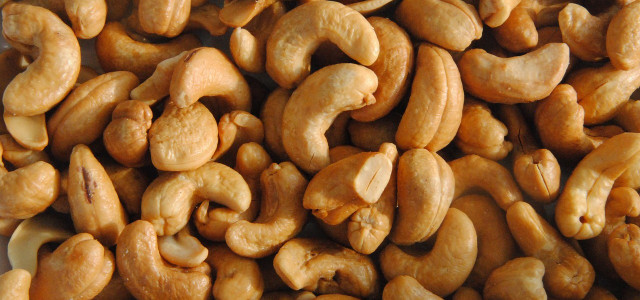How are cashews harvested? Are cashews sustainable? Are they ethical and are they healthy? Are cashews even a nut? Find out all you need to know about cashews by reading more.
Cashews — like many other nuts — have become popular members of the vegan food pyramid and are considered by many experts to be a nutrient-dense addition to any healthy and balanced diet. Cashews have a soft consistency and subtly sweet flavor. Shaped like a boxing-glove, they pack a punch full of nutrition and have multiple applications — particularly as dairy alternatives. Cashews are also being increasingly used as a constituent in muesli, energy bars, cookies, chocolates and ice creams. What’s not to love about cashews?
Like many of our favorite foods, cashew harvesting, production and trade are not without challenges. The cashew itself it not toxic to humans, but its outer coating is — along with some aspects of its supply chain.
The cashew may be an American favorite, however, most Americans are not aware that this unassuming little nut has caused riots and military deployment in Tanzania, as well as turmoil and inequality in many parts of the world. So, let’s take a look at the good, the bad and the ugly aspects of the cashew nut.
Where Are Cashews Harvested?
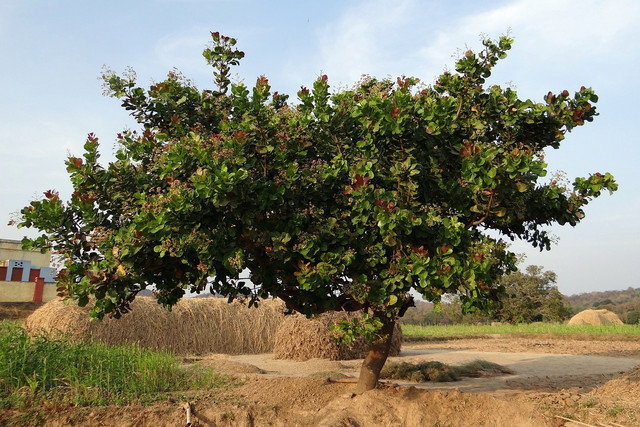
(Foto: CC0 / Pixabay / sarangib)
The cashew tree — Anacardium occidentale — is native to Brazil and was introduced to Asia and Africa by explorers in the sixteenth century. It thrives in tropical climates, therefore, production in the US is minimal.
India is the leading global producer, followed by Ivory Coast, Vietnam and Tanzania respectively. They are also widely cultivated in Guinea-Bissau, Benin, Brazil, East and West Central Africa, South East Asia, South Africa and Australia.
The top three cashew-consuming countries in the world are India, the US and Germany. The US is the leading global importer of cashews and is primarily dependent on Vietnam, Thailand and India for its supply. In-shell cashew imports are very low in the US, as the country primarily depends on shelled cashews from other countries.
The consumption of cashews is majorly concentrated in states like California, Florida, New York, Texas, and New Jersey, but the nuts are widely sold across America. Cashews are expensive though — costing up to seven times more than peanuts. This is because the cashew is an annual crop — harvested only once a year — and also an exceptionally hard nut to crack.
How Are Cashews Harvested?
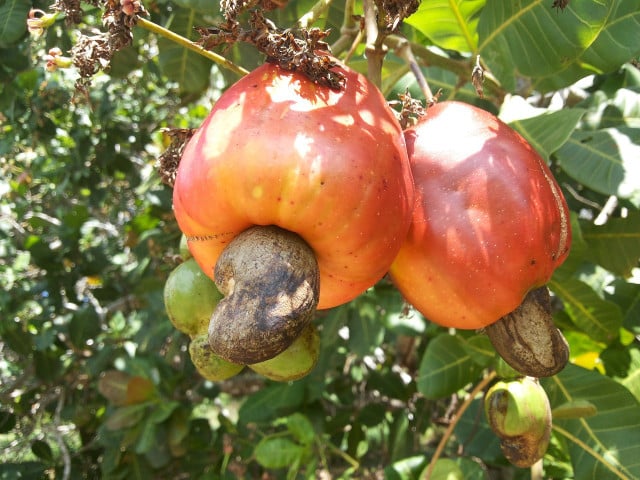


(Foto: CC0 / Pixabay / emidie)
You might be surprised to learn that the cashew isn’t technically a nut. It grows from the bottom of a hanging fruit and is officially categorized as a drupe. Each fruit grows just one cashew nut and workers must separate them by hand. As the seed of the fruit, cashews do not want to be eaten and cashew trees have several defense mechanisms that make harvesting their seeds a complicated process.
Firstly, they have a tough shell to crack — the outside of which contains a caustic anacardic acid — called urushiol — that must be burned off or left to dry under the sun before the nut is touched. The trees are a member of the same family as poison ivy, which also contains this toxic oil. Urushiol causes skin irritation if we are exposed and it sticks to proteins in skin cells. This results in damage to the tissue, swelling, inflammation, pain and blistering.
These reactions worsen with repeated exposure and are a major risk for those harvesting the crops because the nuts are split by hand in many areas — and urushiol is abundant inside too. Cashews are brittle, and intact nuts have a higher market value. Therefore, the process of splitting the shell is an intricate one when done by hand and the use of machinery is not common practice everywhere.
Once split, the nuts must be roasted, boiled or steamed to remove residual toxic substances. Only then are the cashews safe for consumption and to touch.
Are Cashews Ethical?
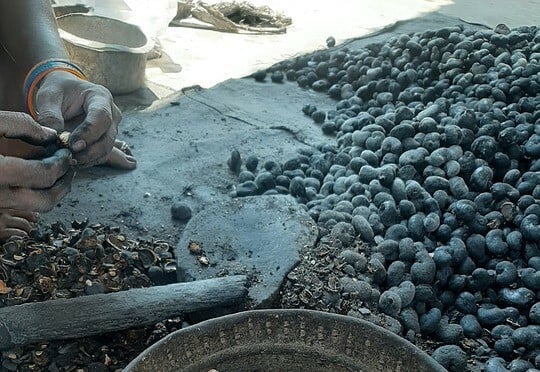


(Foto: CC0 / Pixabay / K_Satish)
Not all cashew-producing countries benefit from the booming global market equally. According to the United Nations Conference on Trade and Development (UNCTAD), all of the 46 countries producing cashew nuts are part of the Global South — with 18 of the least lucrative global economies among them. Many of these countries, particularly throughout Africa, do not have the capacity to process the crops themselves, and more than 85 percent of domestic produce is exported for shelling at low prices — primarily to Vietnam and India.
Exporting Cashews And Shelling Human Rights
The Ethical Trading Initiative and other organizations agree that cashews are harvested in increasing quantities in African countries, including Ivory Coast and Ghana, but are exported elsewhere for processing and sold on at higher profits. UNCTAD also highlights that Africa accounted for 90 percent of global raw cashew nut exports between 2014-2018, while India and Vietnam accounted for a combined share of 98 per cent of raw imports during the same period.
Many African cashew farmers gain only a small share of the value created in the global cashew market. This inequality has caused riots in Tanzania and seen the area under threat of military deployment in the past.
The fact that the nuts are not always processed in the same country they are grown does not just result in financial inequalities, but also contributes to some of the appalling labor conditions that have been uncovered too.
Investigative reports over the last decade have exposed several serious labor and human rights abuses in the cashew nut industry. These include unsafe working conditions, the use of prison labor, child labor, unsafe and lacking contracts.
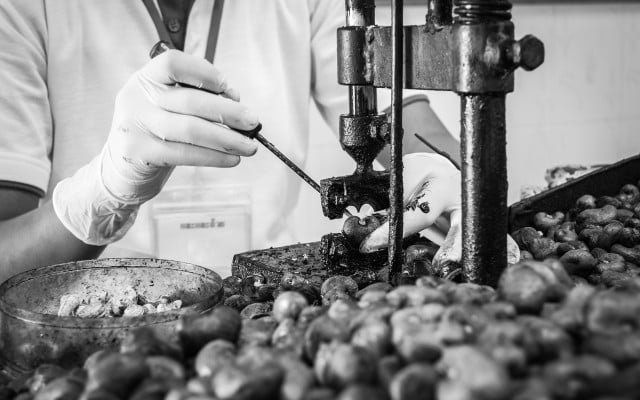


(Foto: Colourbox.de / #81551)
The Toxic Inner Shell Of Cashew Cultivation
Referring to them as ‘blood cashews’ in 2011, Human Rights Watch uncovered forced labor in drug prisons and rehabilitation centers in Vietnam, whereby detainees were forced to work in cashew cultivation and processing for little-to-no wages and risked torture otherwise. Many of these detainees had not voluntarily entered the centers or were being held illegally.
Impact International and other organizations have highlighted a range of other unsafe and unethical practices in several countries, including:
Child labor in Vietnam and India — Including an excess of 14 thousand children working in the Vietnamese cashew industry and a total of 168 million children working in the global industry in unsafe conditions. Many of these children are losing their basic right to attend school.
Unsafe working conditions — Particularly in countries where shelling occurs by hand because of the caustic nature of the acidic shell. Many workers do not have access to gloves and safety equipment and reports have been documented of workers cutting off their badly burned fingers. Eye and respiratory disorders are also reported.
In India, the majority of cashew workers are women, who are completely dependent on the job, and are paid exceptionally low wages. Most workers are paid by volume, therefore speed is crucial at every stage of the manufacturing process — and the reason why many do not wear safety gloves.
Are Cashews Nutritious?



(Foto: CC0 / Pixabay / fernandovillalobos)
So no more of our soft, sweet favorite? Not quite: you can get responsibly sources fair trade cashews. Make sure you buy certified Fairtrade in order to get nuts that were processed under humane conditions, directly support the workers, and respect the local culture and environment. To learn more, read our essential guide Fair Trade: What It Means and Which Certifications You Can Trust.
Buying less, but always fairly traded cashews means you won’t have to miss out completely on their abundant nutritional value. The cashew nut is an excellent source of many essential nutrients — which is a primary reason for its popularity across the globe. Understanding nutrients a little better will help you understand why.
Macro- and Micronutrients in Cashews
Humans rely on the calories in food as fuel for the energy we need to stay healthy. We get these calories from molecules called macronutrients in our food — better known as carbohydrates, fats and protein. We also need ample, but lesser amounts of micronutrients — or vitamins and minerals — and fiber, to achieve a balanced diet and total health. Cashews contain large amounts and healthy ratios of both macro- and micronutrients.
The American Heart Association and most other major health authorities recommend that we eat small amounts of sugar and saturated fat. Many researchers, however, now consider our association between saturated fat and negative health outcomes to be seriously flawed.
Nuts About Fat
While animal fats continue to be associated with negative health outcomes, plant fat does not seem to have the same effects. Unsaturated fats are inarguably healthier than saturated fat — and cashews are a high protein, low sugar and fiber-rich source of these mono- and polyunsaturated fatty acids. Their healthy fat distribution is linked to why cashews are associated with a reduced risk of cardiovascular diseases, improved cholesterol and blood sugar control.
According to other research, cashews also boost the immune system, act as an antioxidant, help to manage gallstones and anemia. The rich constitution of vitamins and minerals is considered the reason for these findings. Just a handful of cashews will contain a substantial amount of iron, zinc, magnesium, phosphorus, selenium, vitamin B, vitamin K, vitamin E, calcium, potassium and more. So, when it comes to nutrition and cashews, we have only positive research and reports.
Very few rivals can deliver over ten percent of our recommended daily intake of protein, fiber, and several vitamins and minerals that an average serving of nuts can. Nuts are so nutritious that the EAT–Lancet Commission on healthy diets from sustainable food systems recommends a significant increase in global consumption of treenuts and groundnuts in view of their nutrient-dense matrix.
These recommendations may require an increase of seven to eleven times current global production, however. Will this increase benefit planetary health as well as humanity’s though?
Are Cashews Sustainable?
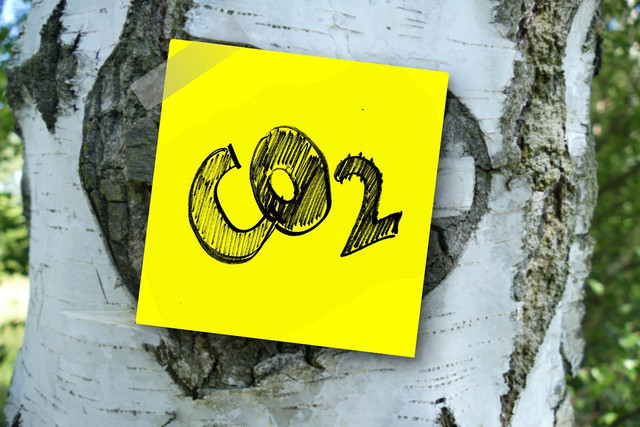


(Foto: CC0 / Pixabay / geralt)
When it comes to sustainability, there are a few dimensions to address in relation to cashews. Firstly, we saw that American cashews are imported — which gives them a significant carbon footprint in itself and impossible to buy locally sourced goods. The fact that many nuts are transported from Africa to India and Asia for processing will also contribute to their impact on the environment. However, when we view their capacity for dairy substitution, that footprint decreases rapidly.
Cashews, Cows And Carbon Footprints
Dairy production on its current massive scale produces greenhouse gases that are rapidly driving climate change. Dairy farms are a leading contributor to greenhouse gas emissions — like methane and carbon dioxide — during the life cycle of milk and other dairy products.
Milk production also impacts the environment when pesticides and fertilizers contaminate soils and water systems. Intensive dairy farming and feed production can also lead to the loss of prairies, wetlands, and forests.
In fact, three of our six foods that are the worst for the environment are animal products, along with plant-based food products that are consumed in high amounts and typically not sourced responsibly: palm oil, cane sugar and coffee.
Cashews — like all plant-based substitutes— pose significantly lower risks to the planet than conventional dairy products, so you might want to make the switch to making cashew milk instead of buying cow milk, or making your cream cheese out of cashews. However, that doesn’t necessarily mean they are eco-friendly. In terms of protein intake, some researchers recommend that we consume our proteins from legumes and cereal grains instead of nuts because of sustainability concerns.
In fact, several nuts present environmental challenges. Treenuts and groundnuts have large water footprints and contribute to blue and severe water stress— with almonds, cashews and pistachios found to be relatively worse-performing than groundnuts. Water stress refers to the vulnerability and resiliency of water resources in a given area. Blue water describes water use from surface freshwater and groundwater in water stress studies, while green water refers to precipitation on land that does not run off. Green water is instead stored in the soil or lingers on top of the soil or its vegetation. Most studies focus on water stress induced by blue water use, but green water use also contributes to water stress in many areas.
Deforestation and Pesticides
Major issues of concern twenty years ago were the conversion of natural forest and land for cashew cultivation — particularly in Africa and Brazil. Increasing demand and export potential is now causing large-scale deforestation in the humid tropics. The nature of the plant’s toxicity tends to discourage other biodiversity in the same areas too.
Cashew farms in Africa and other tropical regions are affected by high pest pressure. This has been shown to result in heavy use of pesticides by the smallholder farmers — many of whom do not possess adequate knowledge of optimal spray regimens or safety behavior.
On the up-side, the cashew’s shell and acidic oil does seem to provide some protection from harmful pesticides. Also, in the 1980s, Embrapa Tropical Agroindustry started a research program which resulted in the propagation of grafted dwarf cashew trees that are resistant to pests and diseases — and have high yields of nuts.
The Cashew Consolations
It isn’t all bad when it comes to cashews and the environment. In fact, cashew plantations are actively sequestering carbon and showing the potential to help to reduce greenhouse gas emissions, at least at regional scale. Add to this, that the cashew tree yields four products — all of which are utilized in ways that include:
- Cashew nut —in processed form is used as an ingredient in a diverse range of foods and food alternatives.
- Cashew apple — is used by national juice and candy companies, making many production chains explore the cashew lifecycle assessment. A Hawaiian startup is now even transforming this byproduct of the cashew nut industry into a nutritious plant-based meat alternative.
- Cashew gum — is extracted from the cashew trunk and has many applications in the food industry as emulsifying, stabilizing, binding, and encapsulating agents, among others.
- Cashew wood — after the renewal of orchards (after 20 years of production) cashew wood is usually used by potteries as a renewable fuel.
Like most of our food choices, there is positive and negative aspects of cashew cultivation and consumption. In view of its potential to bring nutrition and increased socioeconomic stability to the Global South and other populations, many organizations are working towards cashew production that is aligned with our health and climate targets.
If you have decided against adding cashews to your healthy foods list, there are many alternatives that retain similar textures and properties. Pine nuts, zucchini, silken tofu, walnuts, hazelnuts and soaked sunflower seeds can work well in recipes. However, many of these alternative present challenges of their own.
Changing Practices on the Tropical Horizon
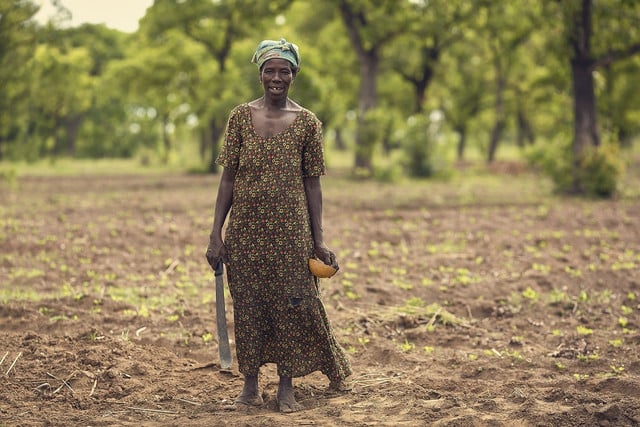


(Foto: CC0 / Pixabay / pochogh)
In 2016, only three percent of cashews sold on the world markets were Fairtrade certified. These challenges and the horrific reports that grew with the cashew’s popularity have, however, resulted in some change and a number of measures to improve the conditions of cashew workers in the tropics and Global South.
Government Investment
Government investment in areas like Ivory Coast has helped cashew farmers to create valuable opportunities and towards financial equality. Government investment has already improved the lives of the local community and to date, has included:
- promoting national cashew processing,
- agreeing with businesses in the sector to support the construction of a local value chain,
- introducing a minimum purchase price in 2013,
- introducing tax incentives,
- taking severe actions to stop smugglers, and
- aiming for a national cashew processing rate of 40 to 50 percent by 2025.
‘Blood Cashews’: What Is the Situation Today?
In 2017, Norwegian food retailers asked the Ethical Trading Initiative Norway (IEH) to reassess the ethics of the cashew nut supply chain in Vietnam in view of the ‘blood cashew’ reports and other negative findings.
They reported that this form of forced labor among detainees and prisoners is now rare and did note several improvements in working conditions generally. However, they did find the following, ongoing challenges:
- Farmers lacked knowledge of child labor requirements.
- Children in the family often work on the farms.
- Farmers lacked knowledge about pesticides and correct handling of them — resulting in polluted ground-water.
- Most workers were employed without work contracts.
- There were numerous health and safety issues, and
- numerous trade union issues.
Tolaro Global: A Women-Led Movement Towards Sustainable Cashew Production
Tolaro Global is a West African company that is part of a world-wide transition towards sustainable agriculture and fair trade for local cashew producers. This combination has created an evolving success story. Tolaro uses sustainable methods and a community-minded ethos to produce its cashews — and cashew products — and is an exemplary example of the power of change.
According to the World Economic Forum, the business employs more than 600 people and over half of its employees are women — as well as three-quarters of its management team. The average Tolaro farmer has increased their yield four times through initiatives like:
- Educating farmers towards better farming practices — through seminars and on-site visits
- Providing the resources needed to put knowledge into practice — including access to farm machinery and equipment
- Providing the “hands on” opportunities to practice — by creating model farms
Conclusion
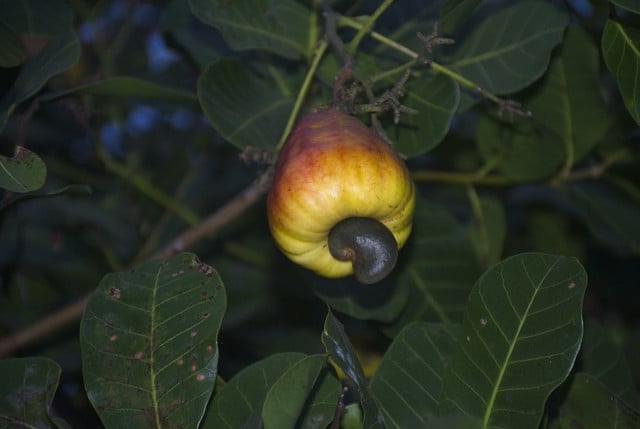


(Foto: CC0 / Pixabay / mussejereissati)
The ethics of cashew production are not a complete disaster and your choice will help drive the positive changes that are developing. An increase in global and government education and investments — alongside fair trading practices — have the potential to turn cashew production into a lucrative boost to local and national economies that are less secure and developed than those that import these nuts in large volumes.
Research your supply chain and bear in mind that that transparency isn’t always guaranteed, not only for cashews, but all other products that are typically imported and consumed in large quantities. Check out our deep dive in sugar to learn more about its ecological impact, for example, or learn about four great reasons to drink fair trade coffee.
Read more:
- 9 Incredible Chocolate Brands for Vegans
- Homemade Oat Milk: A Simple & Sustainable Recipe
- How Do You Make Almond Milk? Easy Homemade Recipe
Do you like this post?






